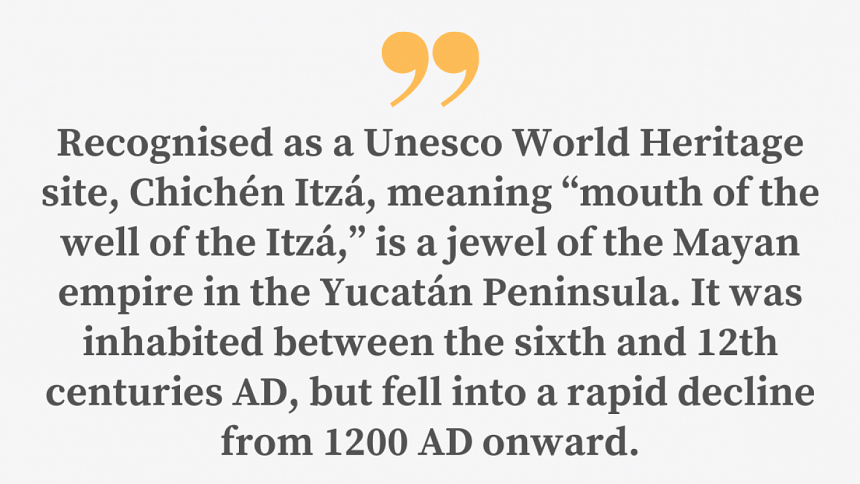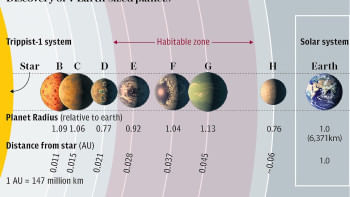Visiting the spirits of the Maya

One of the best ways to understand the social structure, distinctive religious practices, elaborate hieroglyphics, sophisticated calendar systems, and extraordinary achievements in the areas of astronomy and architecture of the Maya, who ruled a large part of Mesoamerica for more than 2,500 years, is by visiting their ruins in the Yucatán Peninsula.
Over the course of a week in December 2022, my wife and I stepped back in time and walked the footsteps of those who lived in the Mayan era at Chichén Itzá and Chacchobén in Mexico, and Nim Li Punit in Belize.
Chichén Itzá
Recognised as a Unesco World Heritage site, Chichén Itzá, meaning "mouth of the well of the Itzá," is a jewel of the Mayan empire in the Yucatán Peninsula. It was inhabited between the sixth and 12th centuries AD, but fell into a rapid decline from 1200 AD onward.
The most iconic structure at Chichén Itzá is El Castillo – an imposing pyramid-like temple built to honour the feathered serpent deity Kulkulcán. Considered one of the seven wonders of the modern world, it was built on top of a cenote – a deep, water-filled sinkhole – because cenotes held great religious significance for the Maya. It has 365 steps, one for each day of the year, and is oriented to mark the solstices and equinoxes. During equinoxes, the setting sun casts shadows on the steps of the pyramid that resemble the body of Kulkulcán.
The Maya were masterful astronomers whose knowledge of the celestial bodies – of Venus, in particular – led to the creation of the Mayan calendars. To them, Venus is a deity and a companion of the sun. From the nearby observatory called El Caracol ("The Snail") and the well-preserved Platform of Venus, they tracked the planet carefully and calculated with amazing accuracy its orbital cycle of 584 days. They also used Venus to determine the length of the year, as well as to schedule various religious rituals.

Flanked by hundreds of columns with carved figures of Maya warriors is the Temple of the Warriors, a massive structure that was used for ceremonial gatherings. Historical documents indicate that the greatest minds of the time met here to accurately predict the dates of eclipses by using the Mayan calendars.
Another interesting structure is the Platform of the Eagles and Jaguars, displaying images representing the course of the sun across the sky during the day and its descent to the underworld at night. The eagles and jaguars on the walls of the edifice are deemed to symbolise two warriors who captured victims and offered them as sacrificial gifts to the gods.
Near El Castillo is the largest ancient ball court in the Americas, where the Maya played Pok-Ta-Pok, a game considered to be metaphorical for the constant battle between the forces of good and evil, and the cycle of life and death. Pok-Ta-Pok involved shooting a rubber ball through a small stone hoop that was incredibly high on a wall using only one's hips, knees, or elbows, without ever using their hands, feet, or head.
The Maya were ahead of their time in many other ways. Their system of numbers and mathematics looks distinctly modern. They invented the concept of zero some 500 years before its introduction in the Eurasian world by Hindu mathematicians, around 600 AD.

Chacchobén
Also known as "The Palace of Red Corn," Chacchobén is an ancient place of Mayan pilgrimage characterised by large temples and massive platforms. Evidence collected during excavations date the earliest human settlements in Chacchobén at around 1000 BC. The site seems to have been abandoned around 1000 AD.
Many temples are still in their natural condition, covered with vegetation and awaiting to be restored to reveal their secrets. Soaring above the canopy of the tropical forest, the stairs of the Gran Basamento ("Great Basement") – leading to a sacred plateau where religious rituals and human sacrifice were enacted – expresses the grandeur of Chacchobén's sophistication.
Nim Li Punit
Nim Li Punit is a small but architecturally unique ancient Mayan site in southern Belize. It flourished from the fifth through eighth centuries AD. In the Maya Kekchi language, Nim Li Punit means "Big Hat," so named due to the depiction on a stela (stone column) of one of its rulers wearing a large hat.
A small museum at the site houses an impressive collection of carved stelae that tell the story of the sovereigns of the city-state in the Maya hieroglyphic script. The largest of them, featuring the eponymous "Big Hat," is one of the biggest stelae ever discovered at Nim Li Punit. A well-kept ball court is also located within the complex.
According to archaeologists, the city was deserted suddenly in the ninth century AD, probably because of area-wide overpopulation exceeding the region's supporting capacity for the then prevalent intercropping farming system. Nevertheless, more than just a pile of rubble, the ruins of Nim Li Punit tell the story of its glorious past.
Despite the punishing heat, humidity, and arduous trek, it was an educational trip for us. We were transported to the past, and witnessed how the Mayan civilisation looked centuries ago. We learned that the Maya deeply believed in the cyclical nature of life: nothing was ever "born" and nothing ever "died." This belief inspired their view of the gods and the cosmos, which, in turn, encouraged their imaginative efforts in the arts and sciences, mathematics, astronomy, and engineering.
Finally, although their cities were abandoned and their culture was subsumed by the Spanish conquistadors in the 16th century AD, the Maya have not vanished.
Today, they farm the same lands, travel the same roads, navigate the same rivers, speak the same indigenous languages, practise the same rituals, and still carry forward the traditions of their great ancestors.
Dr Quamrul Haider is a professor of physics at Fordham University in New York, US.

 For all latest news, follow The Daily Star's Google News channel.
For all latest news, follow The Daily Star's Google News channel. 





Comments